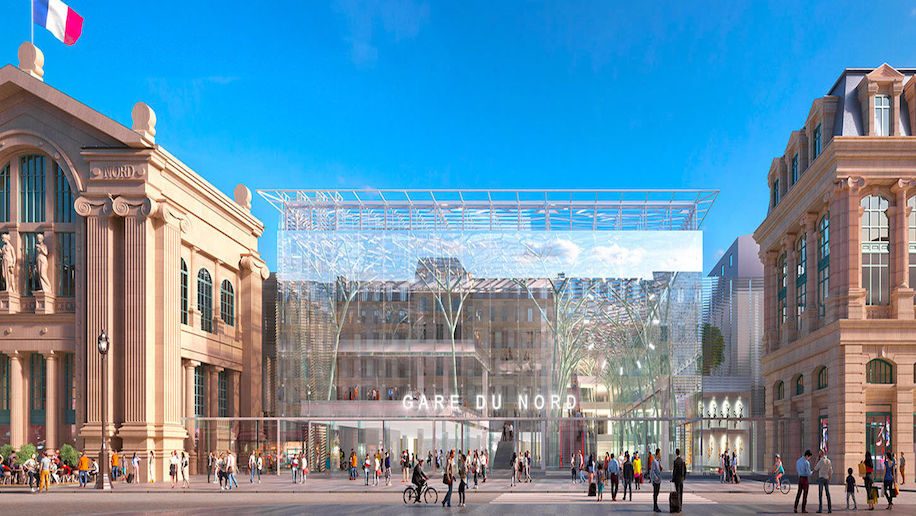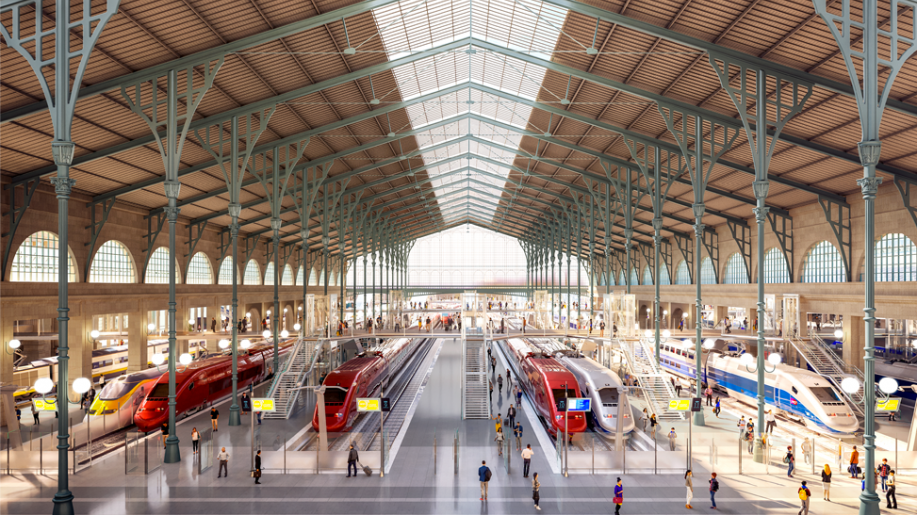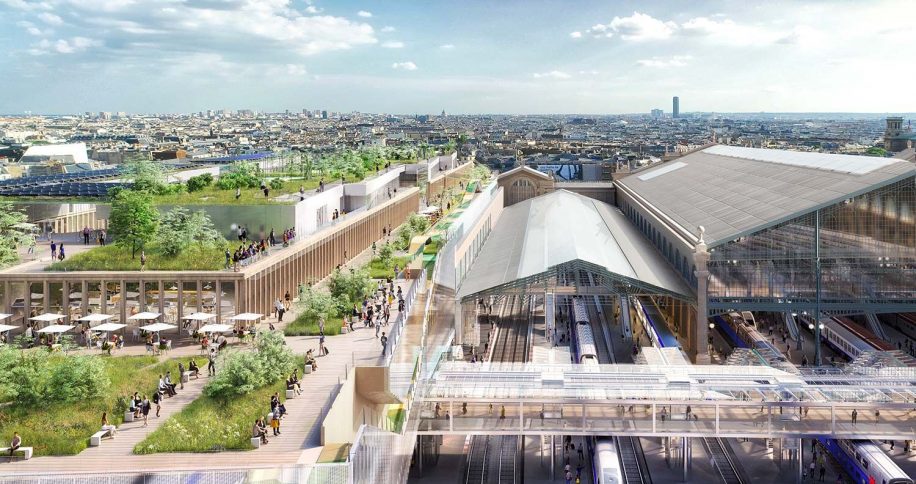
Gare du Nord, Europe’s largest station and home to Eurostar, has never quite matched up to the beauty of its British counterpart St Pancras. Located in the grittier north of Paris, the railway station has been repeatedly lambasted as overcrowded, disorganised and crime-ridden – a rather disappointing introduction to one of the most beautiful cities in the world.
But all of this is set to change – if developers get their way, that is. In anticipation of the 2024 Olympics and Paralympics, the city is looking to refresh the area, starting with the transformation of its main transportation hub.
France’s national state-owned train provider SNCF has partnered with Ceetrus (a subsidiary of French supermarket chain Auchan) and architects Valode and Pistre to draw up plans for a €600 million shopping centre-style extension of the station, known as StatioNord.
The renovation, subject to approval, is modelled on airport design, with a new departures terminal, co-working spaces, a duty-free shopping area, and entertainment and sports facilities.
StatioNord aims to increase the station’s surface area from 75,000 sqm to 136,000 sqm, with five years of phased construction. Renderings showing the “before and after” effect can be viewed here.
The renovation is long overdue. Aside from Eurostar, the station offers regional and local services, including the RER and metro, and currently handles 700,000 passengers per day. This figure is expected to rise to 900,000 by 2030.
The project is not a popular move, however, with its commercial elements criticised by various experts on the matter (more on this later).
A new departures terminal
The main change to the existing structure would be the separation of arrivals and departures, which currently cross over in the Halle Hittorff and are known to cause congestion.
A new departures hall would be located behind a new four-storey glass façade on Rue Faubourg Saint-Denis, with passengers required to pass through retail areas before descending via elevator and escalator to reach the platforms. Three new footbridges are planned along with stairways and escalators to reach the various platforms – similar to the current layout of St Pancras.
Halle Hittorff would be exclusively dedicated to arrivals.

How will this affect the Eurostar terminal?
Many of our readers will have travelled to Paris on the Eurostar, and so will have experienced the Transmanche terminal. With an expected 50 per cent increase in Eurostar traffic for 2030, the project aims to extend the terminal to meet greater demand.
While currently located overhead on a mezzanine, this space would be demolished and replaced by a new terminal to the southeast of the station, adjoining the aforementioned departures hall.
StatioNord claims that this would improve access to the subterranean RER and metro platforms, from which 80 per cent of passengers travelling to London originate.
A new 1,000 sqm space before passport control also features in the plans, hoping to accommodate passengers during extenuating circumstances – a response, no doubt, to last year’s delays and cancellations which led to hour-long queues stretching throughout the station.
The project also aims to revamp the passport control area to limit waiting times, while the waiting area would be enlarged with more shops and dining options.

The creation of a bus and bike station
Gare du Nord currently caters to 13 bus lines and seven night services, but StatioNord also plans to create an electric bus station.
A two-level bike station is also on the cards with 1,200 spaces, 140 of which would be reserved for those using the co-working spaces, and facilities for recharging, repairs and renting.
What entertainment facilities feature in the project?
The plans envisage a new commercial area in the upper floors of the departure building with workspaces, cultural and sports facilities, shops and restaurants.
Features include a concert hall, sports hall, food court, and an open-air sports area with basketball and tennis courts. This would add up to over 18,000 sqm of commercial space, which has been the subject of disagreements (more on this later).

What about green areas?
A major feature of the project is its creation of 7,700 sqm of green areas on the roof of the building. This includes a free public park, an arboretum, a 1km running track, and dining terraces with views across Paris’ famous rooftops.
StatioNord plans to fulfil the aims of the city’s Climate Plan, hoping to achieve four certifications including the BREEAM Outstanding label. The developers plan to use low carbon materials, reduce energy consumption through the use of natural light, use over 50% of renewable energy resources (including solar panels on the roof) and ban single-use plastics and non-biodegradable packaging.
The creation of a bike and electric bus station would also contribute to a reduction in carbon emissions. Developers are also considering dining concepts such as Meet My Mama (food cooked by refugee women) and United Kitchen (which serves food created on-site).

Why is the project unpopular?
The question that many people are asking is whether railway stations should mimic shopping malls and airports. The project has seen heaps of criticism over the past year, viewed as prioritising commercial interests rather than the seamless travel of passengers – travellers would be re-routed through various retail areas before reaching the platforms, increasing journey times.
A group of 19 prominent architects criticised the plans in an open letter to Le Monde in September, describing it as “unacceptable” and demanding that the project be “rethought from top to bottom”. They added: “making hundreds of thousands of people walk through commercial spaces becomes unbearable when this gift to commerce comes with long and unnecessarily complicated journeys.”
The proposal to fill the new space with retail and restaurants is also described as a “serious offense” to travellers, while the timeframe of five years is viewed as “ridiculous”.
Claude Solard, chief executive of SNCF Gares and Connexions, however, defended the project in an op-ed for Le Monde, stating that it would improve the passenger experience, providing greater access and connectivity without a rise in train ticket costs – Ceetrus is providing the funds for the project.
Solard also highlights that this station design isn’t novel to Paris – Montparnasse, Austerlitz and Saint-Lazare already have a similar layout. In response to the commercialisation of space, Solard notes that a balance needs to be found between travellers pressed for time and those who aren’t rushed and want to use dining and co-working facilities.
In further developments, the city hall opposed the plans on Monday, after having appointed four experts to find “improvements which suit all stakeholders.” Libération reported that economist Pierre Veltz, one of the experts and spokesperson for the group, stated that the project’s main issue is its “excessive” extension and advises that the number of retail offerings be reduced.
A public enquiry was launched last November and closed yesterday (January 8). The developers will then have to publish a report to the state representative and await approval of its construction permit. If the project succeeds, works could begin as early as the start of this summer.












